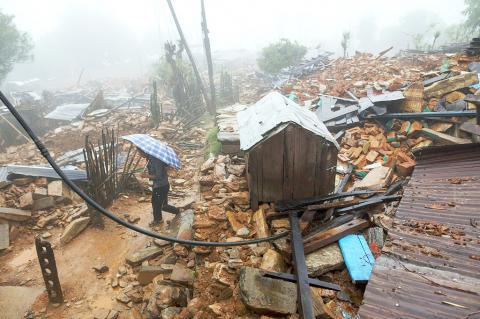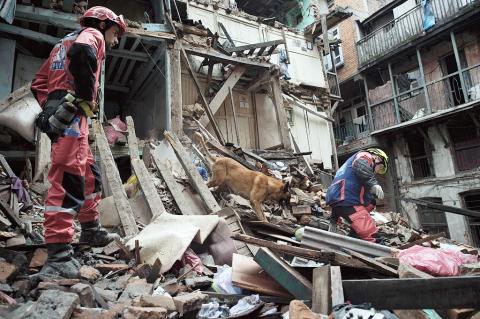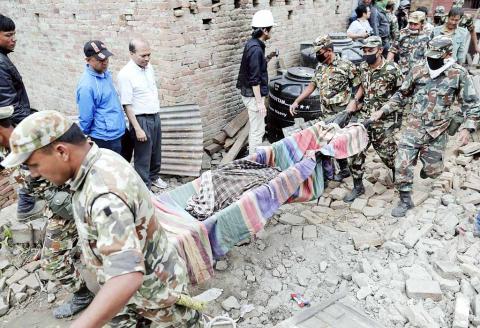The death toll from Nepal’s devastating earthquake could reach 10,000, the prime minister yesterday said, as residents frustrated by the government’s slow response used their bare hands to dig for signs of their loved ones.
“The government is doing all it can for rescue and relief on a war footing,” Nepalese Prime Minister Sushil Koirala said. “It is a challenge and a very difficult hour for Nepal.”
International aid has finally begun arriving in the Himalayan nation of 28 million people, three days after Saturday’s magnitude 7.8 quake, but disbursement is slow. According to the Nepali Ministry of Home Affairs, the confirmed death toll stands at 4,349, with 8,174 injured.

Photo: Reuters
“The death toll could go up to 10,000 because information from remote villages hit by the earthquake is yet to come in,” Koirala said.
The UN said 8 million people were affected by the quake and that 1.4 million people were in need of food.
Meanwhile, up to 250 people were missing yesterday after an avalanche hit the village of Ghodatabela in a popular trekking area to the north of Kathmandu at about noon, Rasuwa District Governor Uddhav Bhattarai said.

Photo: AFP
“This area is in a natural park which is popular with tourists. We are trying to rescue them, but bad weather and rainfall is hampering efforts,” Bhattarai said.
A series of aftershocks, severe damage from the quake, creaking infrastructure and a lack of funds have slowed rescue efforts.
In Kathmandu, youths and relatives of victims were digging into the ruins of destroyed buildings and landmarks.

Photo: EPA
“Waiting for help is more torturous than doing this ourselves,” said Pradip Subba, searching for the bodies of his brother and sister-in-law in the debris of the Dharahara Tower.
“Our hands are the only machine right now,” said the 27-year-old, part of a group of locals pulling out bricks and blocks of concrete with cloth masks over their faces to ward off the stench of rotting bodies. “There is just no one from the government or the army to help us.”
Heavy rain later yesterday slowed down the rescue work.
The head of India’s National Disaster Response Force (NDRF), one of the first foreign organizations to arrive to help, said finding survivors and the bodies of the dead would take time.
NDRF Director General O.P. Singh said heavy equipment could not fit through many of the narrow streets of Kathmandu.
“You have to remove all this rubble, so that will take a lot of time ... I think it’s going to take weeks,” he told Indian television channel NDTV late on Monday.
“The big challenge is relief,” Nepalese Chief Secretary Leela Mani Paudel, the nation’s top bureaucrat, said. “We urge foreign countries to give us special relief materials and medical teams. We are really desperate for more foreign expertise to pull through this crisis.”

LONG FLIGHT: The jets would be flown by US pilots, with Taiwanese copilots in the two-seat F-16D variant to help familiarize them with the aircraft, the source said The US is expected to fly 10 Lockheed Martin F-16C/D Block 70/72 jets to Taiwan over the coming months to fulfill a long-awaited order of 66 aircraft, a defense official said yesterday. Word that the first batch of the jets would be delivered soon was welcome news to Taiwan, which has become concerned about delays in the delivery of US arms amid rising military tensions with China. Speaking on condition of anonymity, the official said the initial tranche of the nation’s F-16s are rolling off assembly lines in the US and would be flown under their own power to Taiwan by way

OBJECTS AT SEA: Satellites with synthetic-aperture radar could aid in the detection of small Chinese boats attempting to illegally enter Taiwan, the space agency head said Taiwan aims to send the nation’s first low Earth orbit (LEO) satellite into space in 2027, while the first Formosat-8 and Formosat-9 spacecraft are to be launched in October and 2028 respectively, the National Science and Technology Council said yesterday. The council laid out its space development plan in a report reviewed by members of the legislature’s Education and Culture Committee. Six LEO satellites would be produced in the initial phase, with the first one, the B5G-1A, scheduled to be launched in 2027, the council said in the report. Regarding the second satellite, the B5G-1B, the government plans to work with private contractors

‘NARWHAL’: The indigenous submarine completed its harbor acceptance test recently and is now under heavy guard as it undergoes tests in open waters, a source said The Hai Kun (海鯤), the nation’s first indigenous defense submarine, yesterday began sea trials, sailing out of the Port of Kaohsiung, a military source said. Also known as the “Narwhal,” the vessel departed from CSBC Corp, Taiwan’s (台灣國際造船) shipyard at about 8am, where it had been docked. More than 10 technicians and military personnel were on deck, with several others standing atop the sail. After recently completing its harbor acceptance test, the vessel has started a series of sea-based trials, including tests of its propulsion and navigational systems, while partially surfaced, the source said. The Hai Kun underwent tests in the port from

MISSION: The Indo-Pacific region is ‘the priority theater,’ where the task of deterrence extends across the entire region, including Taiwan, the US Pacific Fleet commander said The US Navy’s “mission of deterrence” in the Indo-Pacific theater applies to Taiwan, Pacific Fleet Commander Admiral Stephen Koehler told the South China Sea Conference on Tuesday. The conference, organized by the Center for Strategic and International Studies (CSIS), is an international platform for senior officials and experts from countries with security interests in the region. “The Pacific Fleet’s mission is to deter aggression across the Western Pacific, together with our allies and partners, and to prevail in combat if necessary, Koehler said in the event’s keynote speech. “That mission of deterrence applies regionwide — including the South China Sea and Taiwan,” he